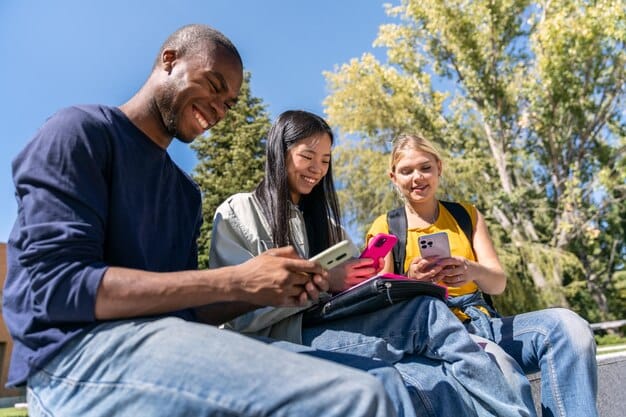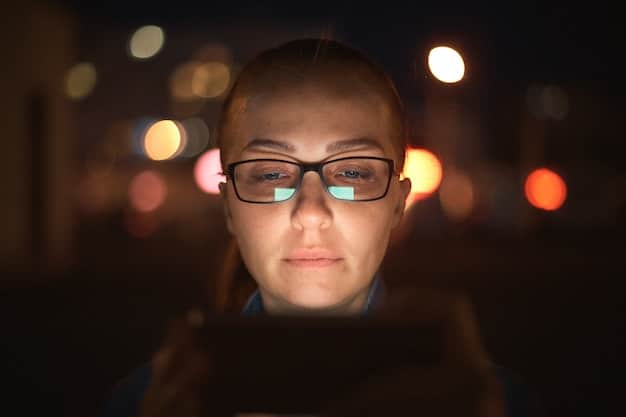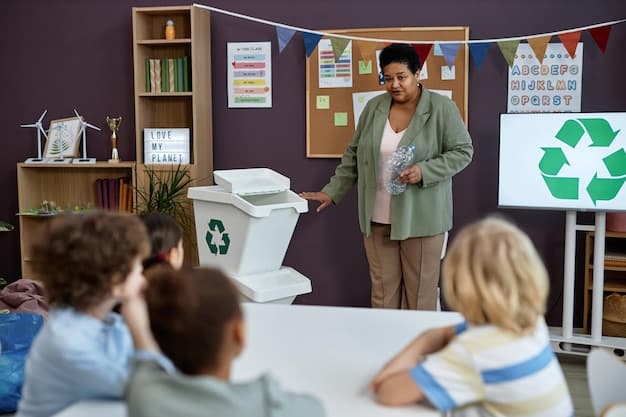The Impact of Social Media on Student Well-being: Research & Strategies

The impact of social media on student well-being is a multifaceted issue, with studies revealing both positive and negative effects, necessitating proactive mitigation strategies to support students’ mental and emotional health.
The pervasive influence of social media in the lives of students is undeniable. But what exactly is the impact of social media on student well-being: research and strategies for mitigation? Let’s explore.
Understanding the Double-Edged Sword of Social Media
Social media has become an integral part of modern life, especially for students. While it offers numerous benefits, such as enhanced communication and access to information, it also presents significant challenges to their well-being.
Understanding these dual effects is crucial for developing effective strategies to mitigate the negative impacts.
The Positive Aspects of Social Media
Social media platforms can serve as valuable tools for education and social connection. They enable students to collaborate on projects, share resources, and stay informed about current events.
- Enhanced Communication: Students can easily connect with peers, family, and educators, fostering a sense of community and support.
- Access to Information: Social media provides quick access to a wealth of information, aiding research and learning.
- Creative Expression: Platforms like Instagram and TikTok allow students to express their creativity and share their talents with a wide audience.
However, these positives are often overshadowed by the potential for negative consequences.

The need to strike a balance is key.
The Negative Effects on Mental and Emotional Health
The dark side of social media is increasingly coming to light. Studies have linked excessive social media use to various mental health issues, including anxiety, depression, and low self-esteem.
Understanding these risks is the first step in protecting student well-being.
Cyberbullying and Online Harassment
Cyberbullying is a pervasive issue on social media platforms. Students can be subjected to harassment, threats, and humiliation, leading to significant emotional distress.
Social Comparison and Low Self-Esteem
The curated nature of social media often leads to unrealistic comparisons. Students may feel inadequate when comparing themselves to the seemingly perfect lives of others online. As a result, lowering self worth.
Social validation plays a role in these feelings:
- Constant Validation: The need for likes and comments can create a dependence on external validation, affecting self-esteem.
- Fear of Missing Out (FOMO): Seeing others’ seemingly exciting experiences can lead to feelings of envy and dissatisfaction.
Identifying these negative effects is vital for implementing effective countermeasures.
Research Findings on Social Media and Student Well-being
Numerous researchers have investigated the correlation between social media and student well-being, providing valuable insights into the scope and nature of this issue.
These studies highlight the importance of addressing social media’s impact proactively.
Research often focuses on usage habits.
Studies on the Amount of Time Spent on Social Media
Research consistently shows that students who spend excessive amounts of time on social media are more likely to experience negative mental health outcomes.
- Increased Risk of Depression: Studies have found a strong correlation between heavy social media use and symptoms of depression.
- Anxiety and Stress: The constant stimulation from social media can contribute to heightened levels of anxiety and stress.
- Sleep Disturbances: Using social media before bed can disrupt sleep patterns, further impacting mental and physical health.
The impact can differ based on usage.
Understanding these research conclusions is crucial for developing targeted interventions.
Strategies for Mitigating Negative Impacts
Implementing effective strategies to mitigate the negative effects of social media is essential for safeguarding student well-being.
These strategies require a collaborative effort from educators, parents, and students themselves.
Promoting Digital Literacy and Critical Thinking
Teaching students how to critically evaluate online content can help them navigate social media more safely and responsibly. Digital literacy programs should address issues such as misinformation, cyberbullying, and online privacy.
Encouraging Mindful Social Media Use
Mindfulness practices can help students become more aware of their social media habits and their emotional responses to online content. Encourage students to take breaks from social media and engage in offline activities that promote well-being.

Mindfulness approaches assist the end user.
Supporting students through these means helps.
The Role of Educational Institutions
Educational institutions play a crucial role in fostering a healthy digital environment for students.
By implementing comprehensive policies and support systems, schools can help students navigate the challenges of social media.
Developing Clear Social Media Policies
Schools should establish clear guidelines regarding acceptable social media behavior, including policies on cyberbullying, harassment, and privacy. These policies should be communicated to students, parents, and staff.
Providing Mental Health Support
Offering access to mental health services, such as counseling and support groups, is essential for students struggling with the negative effects of social media. Schools should also provide educational programs on mental health and well-being.
Promote more well-being.
By establishing protective guidelines, schools can help students navigate social media.
Parental Involvement and Guidance
Parents are important partners in helping students develop healthy social media habits.
Open communication, guidance, and support can make a significant difference in a child’s online experience.
Setting Boundaries and Monitoring Usage
Parents should work with their children to set reasonable limits on social media use and monitor their online activities. This can involve using parental control tools and having open conversations about online safety.
Promoting Offline Activities
Encourage children to engage in activities that promote physical and mental well-being, such as sports, hobbies, and spending time with family and friends. This helps balance their online and offline lives.
Together, these efforts can improve the experience.
| Key Point | Brief Description |
|---|---|
| 😊 Positive Impacts | Social media enhances communication and provides access to information. |
| 😔 Negative Effects | It can lead to mental health issues like anxiety and depression. |
| 📚 Digital Literacy | Promote critical thinking to navigate social media safely. |
| 🤝 Parental Guidance | Parents should set boundaries and encourage offline activities. |
Frequently Asked Questions
▼
Social media can lead to increased anxiety, depression, and negative self-perception due to cyberbullying, social comparison, and the constant need for validation through likes and comments.
▼
Strategies include promoting digital literacy, encouraging mindful usage, setting usage limits, and engaging in offline activities. Schools and parents should work together to foster a healthier digital environment.
▼
Schools should develop clear social media policies, provide mental health support services, and educate students about responsible online behavior and the potential risks associated with social media.
▼
Parents can set usage boundaries, monitor online activity, have open discussions about online safety, and encourage alternative offline activities that promote physical and mental well-being.
▼
“FOMO,” or Fear of Missing Out, refers to the feeling of anxiety or apprehension that one might be missing out on exciting or interesting events that others are experiencing. It’s often amplified by social media.
Conclusion
Addressing the impact of social media on student well-being: research and strategies for mitigation requires a multifaceted approach involving students, educators, and parents collaboratively. By fostering digital literacy, promoting mindful usage, and providing adequate support, we can help students navigate social media safely and responsibly, ensuring their mental and emotional health is protected.





